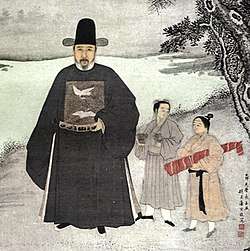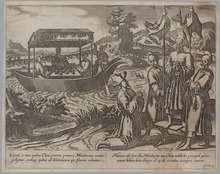Mandarin (bureaucrat)
A mandarin (Chinese: 官; pinyin: guān) was a bureaucrat scholar in the history of China, Korea and Vietnam.
| Mandarin | |||||||
|---|---|---|---|---|---|---|---|
| Chinese name | |||||||
| Chinese | 官 | ||||||
| |||||||
| Vietnamese name | |||||||
| Vietnamese alphabet | quan | ||||||
| Chữ Hán | 官 | ||||||
| Korean name | |||||||
| Hangul | 관 | ||||||
| Hanja | 官 | ||||||
| |||||||



The term is generally applied to the officials appointed through the imperial examination system; it sometimes includes and sometimes excludes the eunuchs also involved in the governance of the two realms.
History and use of the term
The English term comes from the Portuguese mandarim (spelled in Old Portuguese as mandarin, pronounced [ˌmɐ̃n.ðaˈɾĩn]). The Portuguese word was used in one of the earliest Portuguese reports about China: letters from the imprisoned survivors of the Tomé Pires' embassy, which were most likely written in 1524,[1] and in Castanheda's História do descobrimento e conquista da Índia pelos portugueses (c. 1559).[2] Matteo Ricci, who entered mainland China from Portuguese Macau in 1583, also said the Portuguese used the word.[3]
The Portuguese word was thought by many to be related to mandador ("one who commands") and mandar ("to command"), from Latin mandare.[4] Modern dictionaries, however, agree that it was in fact borrowed by Portuguese from the Malay [ˈməntəri], which ultimately came from the Sanskrit mantri (Devanagari: मंत्री, meaning counselor or minister – etymologically linked to mantra).[5][6][7] According to Malaysian Royal Professor Ungku Abdul Aziz, the term had its origin when the Portuguese living in Malacca during the Malacca Sultanate wanted to meet with the higher officials in China, and used the term "menteri", but with an added "n" due to their poor grasp of the language, to refer to higher officials.[8]
In the 16th century, before the term mandarin became widespread in the European languages, the word Loutea (with various spelling variations) was often used in Europeans' travel reports to refer to Chinese scholar-officials. It is frequently used, for example, in Galeote Pereira's account of his experiences in China in 1548–1553, which was published in Europe in 1565, or (as Louthia) in Gaspar da Cruz' Treatise of China (1569). C. R. Boxer says the word comes from the Chinese 老爷 (Mandarin Pinyin: lǎoye; Amoy dialect: ló-tia; Quanzhou dialect: lāu-tia), which was commonly used by people in China to address officials.[9] This is also the main term used to refer to the scholar-officials in Juan González de Mendoza's History of the great and mighty kingdom of China and the situation thereof (1585), which heavily drew (directly or indirectly) on Pereira's report and Gaspar da Cruz' book, and which was the Europeans' standard reference on China in the late 16th century.[10]
In the West, the term mandarin is associated with the concept of the scholar-official, who immersed himself in poetry, literature, and Confucian learning in addition to performing civil service duties.
The speech standard of the Ming and Qing empires was called "Mandarin language" by European missionaries, translating the Chinese name Guanhua ("the language of the officials") for this speech standard, which was current already in the Ming dynasty.[11] The term "Mandarin" is also used to refer to modern Standard Chinese, which evolved out of the earlier standard, and to the broader group of Mandarin dialects spoken across northern and southwestern China.[12]
History
From 605 to 1905, mandarins were selected by merit through the extremely rigorous imperial examination.
China has had civil servants since at least the Zhou dynasty. However, most high ranking positions were filled by relatives of the sovereign and the nobility. It was not until the Tang Dynasty when the final form of the mandarin was completed with the replacement of the nine-rank system. The mandarins were the founders and core of the Chinese gentry. A governmental office (for example, a central government department or a provincial civil governorate) headed by a mandarin is called a yamen. The mandarins were replaced with a modern civil service after the fall of the Qing dynasty.
Vietnam, after becoming free of Chinese rule and setting up its own independent monarchy, emulated the Chinese system of mandarins in its civil service. The last mandarins in history were in service of the State of Vietnam (1949–1955).
Ranks under the Qing dynasty
The Qing dynasty (1644–1912) divided the bureaucracy into civil and military positions, both having nine grades or ranks, each subdivided into primary and secondary categories.[13] Civil appointments ranged from attendant to the emperor or a Grand Secretary in the Forbidden City (highest) to being a county magistrate, prefectural tax collector, deputy jail warden, deputy police commissioner or tax examiner. Military appointments ranged from being a field marshal or chamberlain of the imperial bodyguard to a third class sergeant, corporal or a first or second class private.[13]
In the table below, "na" is shorthand for the "nth rank, primary" (正n品), which is a higher sub-rank than "nth rank, secondary" (從n品), denoted as "nb" in the table.
| Rank | Civil positions | Military positions |
|---|---|---|
| 1a | Attendants to emperor, Grand Secretaries | Field Marshal, Chamberlain of Imperial Bodyguard |
| 1b | Deputy attendants to emperor, attendants to heir apparent, Presidents of Courts, Boards & Censorates | Banner Unit Lieutenant General, Manchu General-in-Chief, Provincial Commander in Chief of Chinese Army |
| 2a | Deputy attendants of heir apparent, Vice Pres. of Courts, Boards, Ministers of Imperial Household, Governor General of Provinces | Banner Captain General, Commandants of Divisions, Brigade General |
| 2b | Chancellors of Imperial Household & Hanlin Institute, Superintendent of Finance, Provincial or Assistant Governors | Major General, Colonel |
| 3a | Assistant Vice Presidents in the Censorate, Provincial Judge, Director of Courts & Activities | Brigadiers of Artillery & Musketry, Brigadier of Scouts, Banner Division Colonel |
| 3b | Director of Imperial Banqueting, Director of Imperial Stud, Salt Controller | Banner Brigade Commander Outside Beijing |
| 4a | Director & Assistant Directors of Imperial Household, Courts, Censorate, Foreign Relations & Circuit Attendants | Lieutenant Colonel of Artillery, Musketry & Scouts Captain, Police Major in Beijing |
| 4b | Instructors in Grand Secretariat & Hanlin Institute, Prefects | Captain, Assistant Major Domo in Princely Palaces |
| 5a | Deputy Supervisors of Instruction at Hanlin Institutes, Sub-Prefects | Police Captain, Lieutenant or First Lieutenant |
| 5b | Assistant Instructors and Librarians at Imperial and Hanlin Institutes, Assistant Directors of Boards and Courts, Circuit Censors | Gate Guard Lieutenants, Second Captain |
| 6a | Secretaries & Tutors at Imperial & Hanlin Institutes, Secretaries and Registrars at Imperial Offices, Police Magistrate | Bodyguards, Lieutenants of Artillery, Musketry & Scouts, Second Lieutenants |
| 6b | Assistant Secretaries in Imperial Offices and Law Secretaries, Provincial Deputy Sub-Prefects, Buddhist & Taoist priests | Deputy Police Lieutenant |
| 7a | Assistant Police Magistrates, Studies Registrars, Directors of Studies in Beijing, District magistrates | City Gate Clerk, Sub-Lieutenants |
| 7b | Secretaries in Offices of Assistant Governors, Salt Controllers & Transport Stations | Assistant Major Domo in Nobles' Palaces |
| 8a | Assistant District Magistrates, Prefectural Secretaries, District Director of Studies | Ensigns |
| 8b | Sub-director of Studies, Archivists in Office of Salt Controller | First Class Sergeant |
| 9a | Jail Wardens, District Registrars, Prefectural Archivists | Second Class Sergeant |
| 9b | Prefectural Tax Collector, Deputy Jail Warden, Deputy Police Commissioner, Tax Examiner | Third Class Sergeant, Corporal, First & Second Class Privates |
During the Qing dynasty, the governor of a Chinese province was signified by wearing a mandarin hat-pin made of ruby. The lower ranks of mandarins were signified by hat-pins made of coral, sapphire, lapis lazuli, white jade, gold, and silver.[14]
Figurative meaning
In modern English, mandarin is also used to refer to any (though usually a senior) civil servant, often in a satirical context,[15] and particularly in the United Kingdom and Commonwealth countries.
See also
- Yangban – the traditional ruling class or gentry of dynastic Korea during the Joseon Dynasty
- Kapitan Cina – the Chinese officership or mandarinate of colonial Indonesia
- Cabang Atas – the Chinese gentry of colonial Indonesia
- Mandarin Chinese
- Mandarin cuisine
References
- Letters from Portuguese captives in Canton, written in 1534 & 1536: with an introduction on Portuguese intercourse with China in the first half of the sixteenth century. Educ. Steam Press, Byculla. 1902.. The letters were not published at the time, but apparently distributed in manuscript form; Ferguson published the copy found in a Paris library. While Ferguson accepted the 1534 and 1536 dates given in the Paris manuscripts, later researchers concluded that in reality the letters were sent in 1524 (Boxer et al. 1953, p. xxi). In the letters the word occurs numerous times in its plural form, both with a final n/m: mandarĩs, manderĩs, manderỹs and without it: mandaris, manderys, mandarys. (Note that in the 16th-century Portuguese orthography, one would often put a tilde over a final vowel instead of writing an n or m after the vowel; thus ĩ or ỹ would be transcribed as in/im or yn/ym in most modern reprints.)
- Fernão Lopes de Castanheda, História do descobrimento e conquista da Índia pelos portugueses, Vol. VI, cap II, 26. Castanheda's spelling (in plural) is still mandarins.
- Matteo Ricci, De Christiana expeditione apud Sinas. Page 45 in the English translation, "China in the Sixteenth Century: The Journals of Matteo Ricci", Random House, New York, 1953. In the original Latin, vol. 1, p. 51: "Lusitani Magistratus illos, à mandando fortasse, Mandarinos vocant, quo nomine iam etiam apud Europæos Sinici Magistratus intelliguntur".
- Johnson, Samuel (1827). Dictionnary of the English Language. Longman.
- Mandarin, Online Etymology Dictionary
- Mandarin Merriam-Webster
- "mandarin", Shorter Oxford English Dictionary. 1 (6th ed.). Oxford University Press. 2007. ISBN 978-0-19-920687-2.
- Ku Seman Ku Hussain; Hafizahril Abdul Hamid (19 July 2009). "PPSMI satu kesilapan" [PPSMI a mistake]. Mingguan Malaysia (in Malay). Kuala Lumpur: Utusan Melayu (M) Berhad. p. 7.
Jadi perkataan menteri itu disebut kepada "menterin" dan apabila mereka pergi ke negeri China untuk berjumpa dengan pegawai tinggi akhirnya perkataan "menterin" tadi bertukar kepada "Mandarin".
- Boxer, Charles Ralph; Pereira, Galeote; Cruz, Gaspar da; de Rada, Martín (1953), South China in the sixteenth century: being the narratives of Galeote Pereira, Fr. Gaspar da Cruz, O.P. [and] Fr. Martín de Rada, O.E.S.A. (1550–1575), Issue 106 of Works issued by the Hakluyt Society, Printed for the Hakluyt Society, p. 10 sq.. Minnan (Amoy and Quanzhou) pronunciation is given as per C.R. Boxer, whose source is Carstairs Douglas's Dictionary of the Amoy vernacular.
- "LOUTEA, LOYTIA, &c" in: Yule, Sir Henry; Burnell, Arthur Coke (1903), Crooke, William (ed.), Hobson-Jobson: a glossary of colloquial Anglo-Indian words and phrases, and of kindred terms, etymological, historical, geographical and discursive, J. Murray, pp. 522–523
- Guanhua is transcribed by Matteo Ricci and other early European writers as Quonhua, in accordance with Ricci's transcription system that remained in use by Jesuits for a long time after his death. See pages 28–29 in the English translation, China in the Sixteenth Century: The Journals of Matteo Ricci, Random House, New York, 1953. In the original Latin, De Christiana expeditione apud Sinas suscepta ab Societate Jesu (1617), vol. 1, p. 31: "Præter hunc tamen cuique Provinciæ vernaculum sermonem, alius est universo regno communis, quem ipsi Quonhua vocant, quod curialem vel forensem sonat."
- Norman, Jerry (1988). Chinese. Cambridge University Press. p. 136. ISBN 978-0-521-29653-3.
- Beverly Jackson and David Hugus Ladder to the Clouds: Intrigue and Tradition in Chinese Rank (Ten Speed Press, 1999) pp. 134–135.
- Bonavia, David Peking New York:1978 Time-Life Books Great Cities of the World series Page 157
- e.g. as in the titles of such works as The Mandarins by Simone de Beauvoir, Chomsky's American Power and the New Mandarins, etc.